
The concept of a drilling, a 3 barrel gun is an interesting one. You have a rifle and shotgun in one combination gun. Where it’s legal you can hunt both large and small game at the same time and instantly shoot the appropriate barrel.
Most double rifles and drillings are handy and well balanced making them easy to carry and shoot. While not long range precision instruments, they will cover quite a few hunting situations. Many have provisions for scope mounting which helps with accuracy and range. They are well liked in areas that feature game that can eat or stomp you into a mud puddle. There is a lot to be said about having two rapid shots when the chips are down. They come in a variety of calibers from the 22 Hornet on up to the 750 Nitro Express which by the way I have no intentions of ever shooting, as I don’t anticipate the return of the dinosaurs anytime soon, and the shotguns are usually a 12 or 16 gauge.

Shooting a J Reeb Drilling
Many of the older drillings have short chambers for the shotguns such as a 16 gauge 2 & 5/8 rather then the standard 2 & ¾ so keep that in mind when shooting shotgun shells. If they have Damascus barrels then black powder loads should be utilized as they were made in the 1800’s. They are more popular in Europe then here though they do have a following in the US. They are desirable to some because of the superior balance and the ability to shoot a shotgun shell or a rifle round merely by flicking a switch or pulling the desired trigger. Another advantage is some countries regulate how many guns you are allowed to own so drillings make perfect sense in that scenario.
You basically have two weapons in one. They are more complicated then many other weapons thus are more expensive and some are works of art. Many of the receivers and barrels have fine engraving on them and the wood may be a work of art. Finding the proper chambering, however, can be a challenge best left to someone with that type of experience. Many of them are not a fountain of information when it comes to giving info on the chamberings. Some makers chambered their gun for a cartridge just for that gun so other ammo makers wouldn’t would make ammo for it. Many of the cartridges have several variations which makes life interesting. The 500/450 for example has as many as 19 different variations according to some sources.
A customer brought several drillings to get ammo made for them. He picked them up at an estate sale and wanted to shoot them, however no ammo came with them nor were there any indication of chamberings. Of course, no loading dies came with them either. Though I had my work cut out for me, I regarded it as a challenge rather then a problem. To determine the chamber dimensions I did chamber casts on them with Cerrosafe and slugged the bores. Cerrosafe is the best material to use as it has a low melting point about 170 degrees and is available from Brownells or Midway. It also gives you an accurate picture of the chamber. It is also reusable another desirable point.
Doing a chamber cast with these is easy because you don’t have an action to deal with such as a bolt or lever. I put a slug about an inch into the rifling, that way I can get a reading on both the chamber and rifling at the same time. I also examined them for any cracks or any other defects that would have precluded shooting them. It’s important to thoroughly inspect those old guns before attempting to fire them to avoid serious injury. Using a magnifying glass isn’t a bad idea to check for hairline cracks or other defects that may not be obvious to the naked eye. If you are not sure of the soundness then either have a qualified gunsmith examine it or hang it on the wall. You may run into one that has been victimized by a basement gunsmith in which case it probably isn’t safe to shoot. I have seen a couple of examples where someone took a chisel or screwdriver to the action producing gouges. My guess is they got a round stuck in the gun and that was their method for removing it. What a shame as the gun was ruined for further use. When working on these guns the ability to think outside the box is a major asset.
One of the main objectives in duplicating the ammo is to get it to shoot as close as possible to the point of aim. Trying to squeeze out the maximum velocity is seldom a good idea in either accuracy or safety. Many of those combination guns are quality items but there are exceptions.
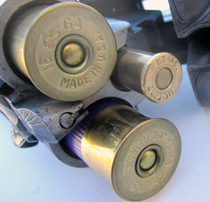
Closeup of drilling
Another one of his drillings is a 16 gauge and 44 Caliber made by JP Saur & Sohn Suhl. Other numbers that may be patent dates show on barrels as well. The shotgun barrels are pitted to a fairly extensive part of the barrels while the rifling in the 44 barrel is pretty decent with minor pitting. Minor pitting doesn’t generally hurt accuracy too much as long as you don’t let any leading build up. Action and various parts are heavily engraved and the barrels are 27 & ¾” long. The quality is obvious on all parts on the gun although it has seen some hard use. It has a push down lever on the side that opens the action and a lever on top to switch from rifle to the shotgun barrel. Pushing it left enables you to shoot the rifle barrel. The trigger pull is very manageable unlike some of the other drillings I have fired. The butt pad is chewed up and worn but is serviceable. It also sports a flip up peep sight. Barrel slugged out @ .439 and 444 Marlin case fit though not all the loaded ammo would. That continues to be a puzzling problem as some would fit. Running them in a sizing die did not always help. Fired it with 15 X Unique and a 200 grain lead bullet and 12 X Unique and a 240 grain round nose to get cases. Most of the shells worked fine but a few would not come out after firing. There was some swelling evident but the whole case swelled evenly at 459. A 44 bullet dropped down in the case and in fact a .439 diameter bullet easily fit in the case. I slugged the back of the barrel and it showed .439 so I loaded some 370 grain 439 bullets ahead of 58 grains of FFG. I would not fire a full power 444 Marlin in this gun as it has some age on it. Some folks believe that if a round fits in a gun it is ok to shoot it. Nothing can be further from the truth. I wonder how many guns were destroyed and people injured who subscribe to that theory.
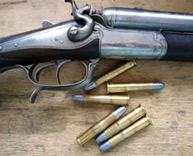
J Reeb with 11 X 50 Ammo
I fired 58 grains of FFG Graff black powder behind a 370 grain .439 diameter bullet. They shot ok and no problem chambering or removing fired cases. It's these life’s little mysteries that makes it interesting. Due to its condition I didn’t feel comfortable using any smokeless loads so I didn’t. Black powder and Clean Shot produce less pressure than smokeless powders making them safer in old guns. Pyrodex is also suitable for this purpose.
| LOAD | BULLET | VELOCITY | COMMENT |
| 58 X FFG Graff | 370 grain | 1067 | slow |
| 50 X FFG Clean Shot | 370 grain | 1250 | good load |
This drilling has 2-16 gauge barrels on top and a 9 mm rifle barrel. Like the 25, the barrels are 27 & ½” long. It has the name E. Pachmaxr on one barrel and the other has Trainsteen and nitro on the other barrel. It gives no clue as to what caliber the combination gun might be. It has dual hammers in the style of the early 20’Th century. The hammer on the right can either fire the 16 gauge barrel or if you move the top lever to your left it will fire the rifle barrel. The gun opens by an under lever and is lighter then expected due the thin rifle barrel. It is well balanced and should be easy to track a target.
Since there was no indication of what they shoot I knew my work was cut out for me. I was confident that my local gun store did not stock ammo for either. It turned out to be a good light load then loaded some up with 36 X 4197 and a 158 grain hollow point sized to 356. They shot ok.
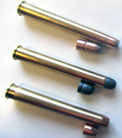
Closeup of drilling
I made up some loads for it by extrapolating and educated guess work. I did not try to get max velocities just good working loads. All bullets in the 9 mm were sized to 356. There is an obscure round called the 9 X 57 R and this is what it appears to be. It should not be confused with the 9 X 57 rimless which an old cartridge based on the 8 X 57 round is necked up. I use conventional 9 X 57 dies and just size the front of the case. If you need to resize the rear try the 9.3 X 72 dies for best results. The 16 gauge barrels shot ok for the few times that I tried them.
Loads for the 9 x 57 mm drilling all bullets sized to .356
| 10 X Unique | 115 grain 9mm fmj | 1443 | small game |
| 12 X Herco | 125 grain HP | 1552 | fair |
| 9 X Unique | 140 grain HP | 1243 | ok |
| 8 X Unique | 158 grain cast RN | 1366 | ok |
| 36 X 4197 | 158 grain HP | 2034 | ok |
| 30 X IMR 4198 | 180 grain FP | 2198 | good load |
| 26 X IMR 4198 | 200 grain FMJ | 1953 | mild |
| 30 X IMR 4895 | 200 grain RN | 1560 | nice |
The fun begins when you want to shoot the rifle barrel. Frequently the barrels are not marked and each maker chambered his guns for unique cartridges designed by his company. That is where advanced ammo making and reloading techniques come in handy. You have to have a good understanding of these guns to make safe and shootable ammo. Some are made back in the last quarter of the 19th century to the early years of the 20’th.
You should ascertain that the gun is sound and safe to shoot. If not sure, consult a competent gunsmith beforehand. Many of the drillings were made in Germany, which generally guarantees good quality. Some made elsewhere may or may not be so good. They are complicated and expensive to make because of the firing mechanisms. You generally have two triggers to fire three barrels which necessitates a lever on top or the side to determine which barrel you want to fire. That involves extra parts and fitting which adds to the cost.
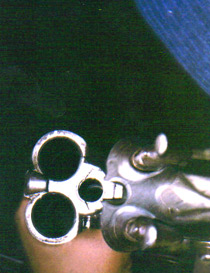
16 gauge and 9 mm drilling
Another drilling I made ammo for was made by a J. Reeb who made guns many years ago in Germany. It is a well made piece though there is no engraving that is found on some. Typical of the day the hammers are hard to cock and the triggers have a heavy pull. I did a chamber cast and determined that it is a 11 X 60 Mauser round but 3/8” was cut off of the neck. I made a test round and it fired perfectly so I trimmed a bunch of cases for working up a load for the owner who wants to hunt with it. It has provisions for a claw mount so when he has one custom made he can use a scope if desired. Since it shoots an 11 mm bullet big game at moderate ranges is a viable option. The rifling is good so I obtained some good working accuracy from it. The customer doesn’t want black powder which brings up another challenge. Is it safe to shoot with light loads of smokeless.? Through various ways, I determined that it was. Since I have worked with similar guns and calibers in the past I felt on safe ground working up a couple of loads. I have worked with a couple of 11 X 60 Mausers one was a double rifle that is quite old. Since this cartridge has a shorter neck, I reduced the powder charge by a few grains from the Mauser loads. The process is called extrapolation and should be attempted by very experienced reloaders only. I am happy with these loads as they give plenty of velocity without straining the old gun. These loads would be very adequate for deer and black bear at woods ranges. Once a scope is mounted it will make a nice addition to any hunting rifle collection. The iron sights are not that good. And gun shoots high.
| LOAD | BULLET | VELOCITY | COMMENT |
| 31 X 5744 | 300 grain cast | 1615 | very consistent |
| 37 X IMR 4198 | 300 grain cast | 1698 | ok |
| 27 X 5744 | 370 grain cast | 1388 | very consistent |
| 33 X IMR 4198 | 370 grain cast | 1517 | ok |
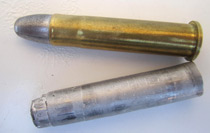
45-70 case necked to 11 mm for drilling shown with chamber cast
It’s always a great opportunity to get an old combination gun to shoot well. I loaded some black powder 16 gauge and they shot fine. The owner reported that he was breaking doubles in skeet. Drillings and double barrel rifles have special challenges but that is what makes them so interesting.
DISCLAIMER: All reloading data in this article is for informational purposes only. Starline Brass and the author accept no responsibility for use of the data in this article.